ECON 940 Statistics: Analyzing Consumer Behavior in Car Market
VerifiedAdded on 2023/06/10
|32
|5243
|417
Report
AI Summary
This business report analyzes the demand for BMW, Lexus, and Mercedes luxury cars based on customer age, income, and education. A survey of 420 samples reveals that Mercedes is the most preferred, followed by Lexus and BMW. BMW buyers tend to be younger with lower incomes and fewer years of education. Statistical analysis, including ANOVA tests, confirms significant differences in mean income, age, and education among the buyer groups. Logistic regression indicates that older individuals with higher incomes and more education are more likely to purchase Mercedes. The report uses descriptive statistics to understand the distribution of age, income, and education, and provides insights into consumer preferences to help car sellers target their consumers and maximize revenue.
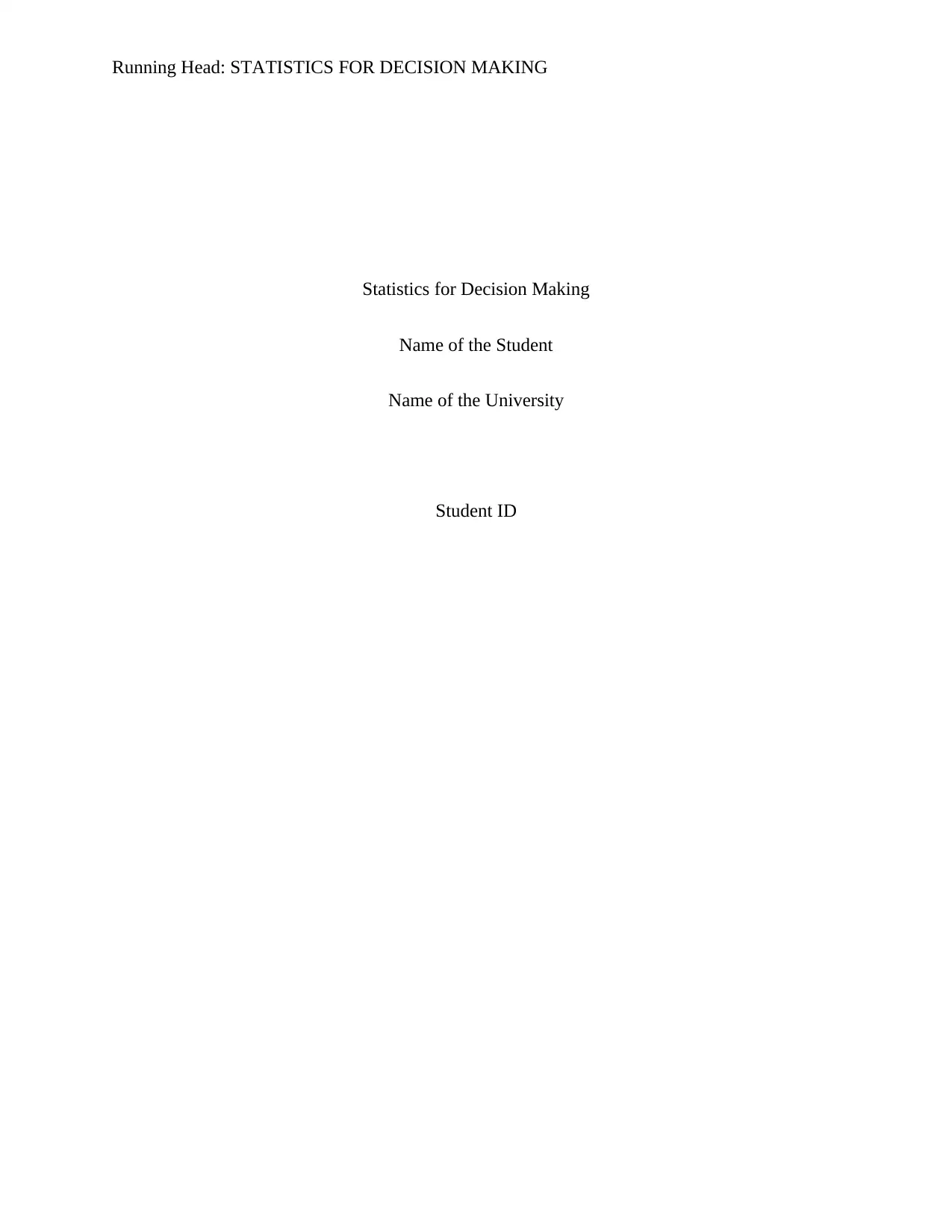
Running Head: STATISTICS FOR DECISION MAKING
Statistics for Decision Making
Name of the Student
Name of the University
Student ID
Statistics for Decision Making
Name of the Student
Name of the University
Student ID
Paraphrase This Document
Need a fresh take? Get an instant paraphrase of this document with our AI Paraphraser
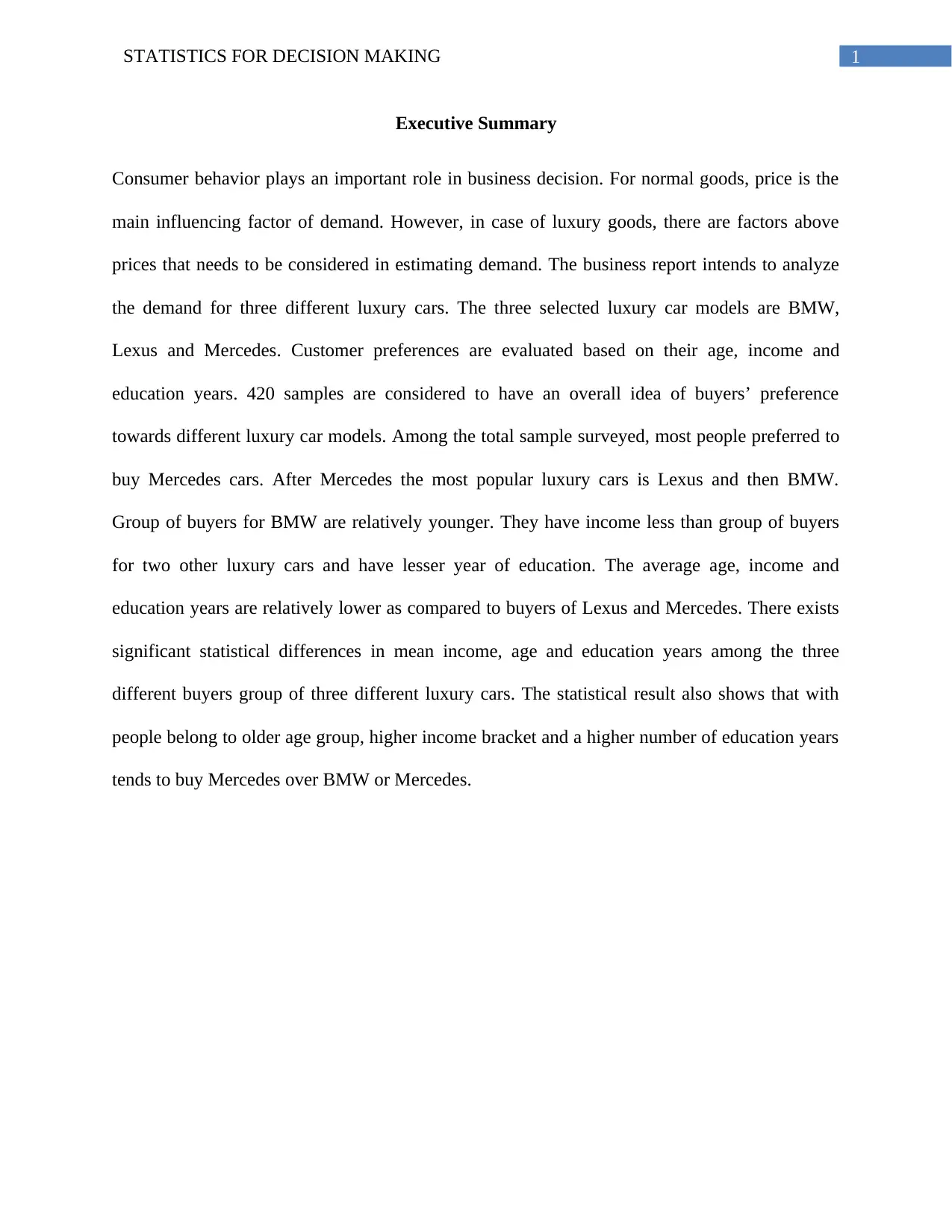
1STATISTICS FOR DECISION MAKING
Executive Summary
Consumer behavior plays an important role in business decision. For normal goods, price is the
main influencing factor of demand. However, in case of luxury goods, there are factors above
prices that needs to be considered in estimating demand. The business report intends to analyze
the demand for three different luxury cars. The three selected luxury car models are BMW,
Lexus and Mercedes. Customer preferences are evaluated based on their age, income and
education years. 420 samples are considered to have an overall idea of buyers’ preference
towards different luxury car models. Among the total sample surveyed, most people preferred to
buy Mercedes cars. After Mercedes the most popular luxury cars is Lexus and then BMW.
Group of buyers for BMW are relatively younger. They have income less than group of buyers
for two other luxury cars and have lesser year of education. The average age, income and
education years are relatively lower as compared to buyers of Lexus and Mercedes. There exists
significant statistical differences in mean income, age and education years among the three
different buyers group of three different luxury cars. The statistical result also shows that with
people belong to older age group, higher income bracket and a higher number of education years
tends to buy Mercedes over BMW or Mercedes.
Executive Summary
Consumer behavior plays an important role in business decision. For normal goods, price is the
main influencing factor of demand. However, in case of luxury goods, there are factors above
prices that needs to be considered in estimating demand. The business report intends to analyze
the demand for three different luxury cars. The three selected luxury car models are BMW,
Lexus and Mercedes. Customer preferences are evaluated based on their age, income and
education years. 420 samples are considered to have an overall idea of buyers’ preference
towards different luxury car models. Among the total sample surveyed, most people preferred to
buy Mercedes cars. After Mercedes the most popular luxury cars is Lexus and then BMW.
Group of buyers for BMW are relatively younger. They have income less than group of buyers
for two other luxury cars and have lesser year of education. The average age, income and
education years are relatively lower as compared to buyers of Lexus and Mercedes. There exists
significant statistical differences in mean income, age and education years among the three
different buyers group of three different luxury cars. The statistical result also shows that with
people belong to older age group, higher income bracket and a higher number of education years
tends to buy Mercedes over BMW or Mercedes.
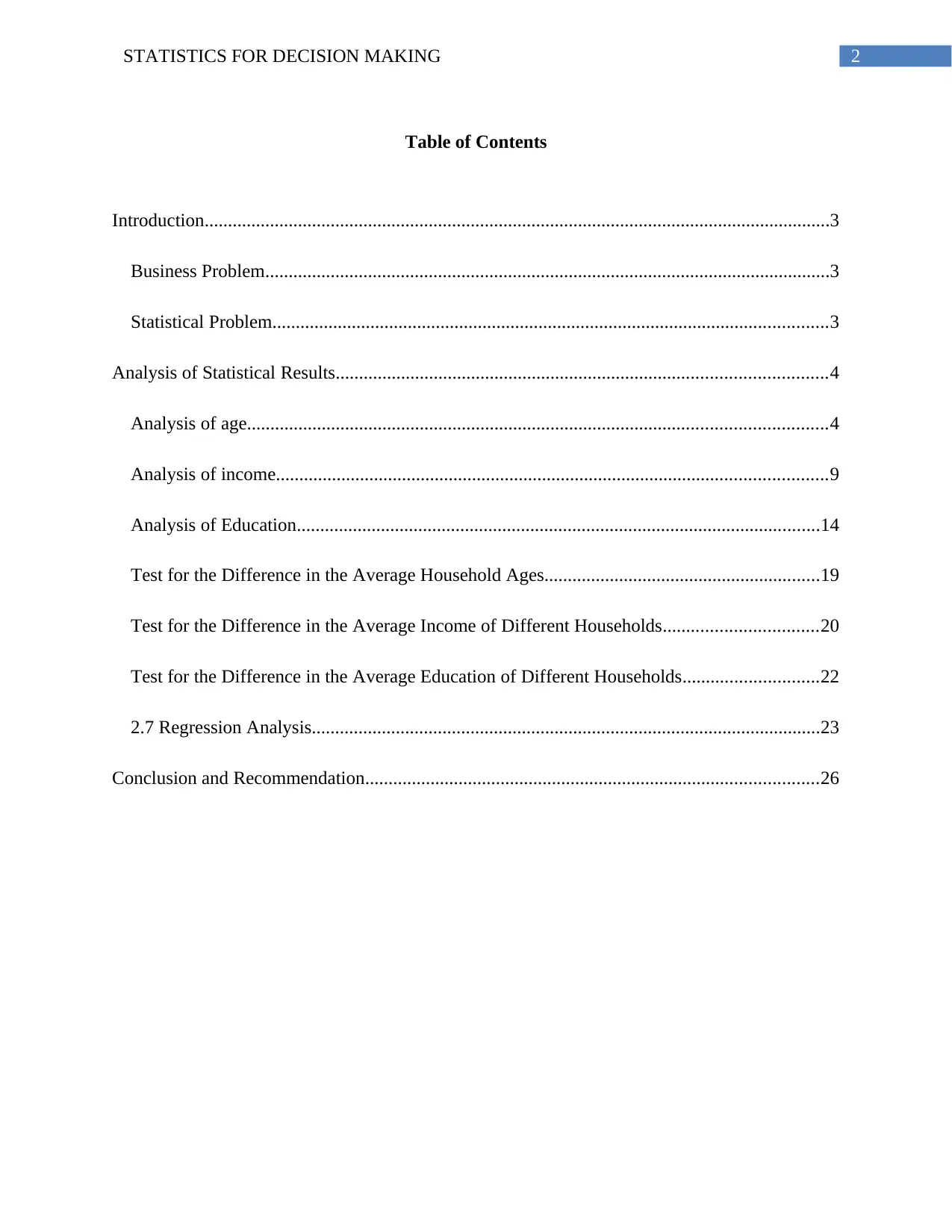
2STATISTICS FOR DECISION MAKING
Table of Contents
Introduction......................................................................................................................................3
Business Problem.........................................................................................................................3
Statistical Problem.......................................................................................................................3
Analysis of Statistical Results.........................................................................................................4
Analysis of age............................................................................................................................4
Analysis of income......................................................................................................................9
Analysis of Education................................................................................................................14
Test for the Difference in the Average Household Ages...........................................................19
Test for the Difference in the Average Income of Different Households.................................20
Test for the Difference in the Average Education of Different Households.............................22
2.7 Regression Analysis.............................................................................................................23
Conclusion and Recommendation.................................................................................................26
Table of Contents
Introduction......................................................................................................................................3
Business Problem.........................................................................................................................3
Statistical Problem.......................................................................................................................3
Analysis of Statistical Results.........................................................................................................4
Analysis of age............................................................................................................................4
Analysis of income......................................................................................................................9
Analysis of Education................................................................................................................14
Test for the Difference in the Average Household Ages...........................................................19
Test for the Difference in the Average Income of Different Households.................................20
Test for the Difference in the Average Education of Different Households.............................22
2.7 Regression Analysis.............................................................................................................23
Conclusion and Recommendation.................................................................................................26
⊘ This is a preview!⊘
Do you want full access?
Subscribe today to unlock all pages.

Trusted by 1+ million students worldwide
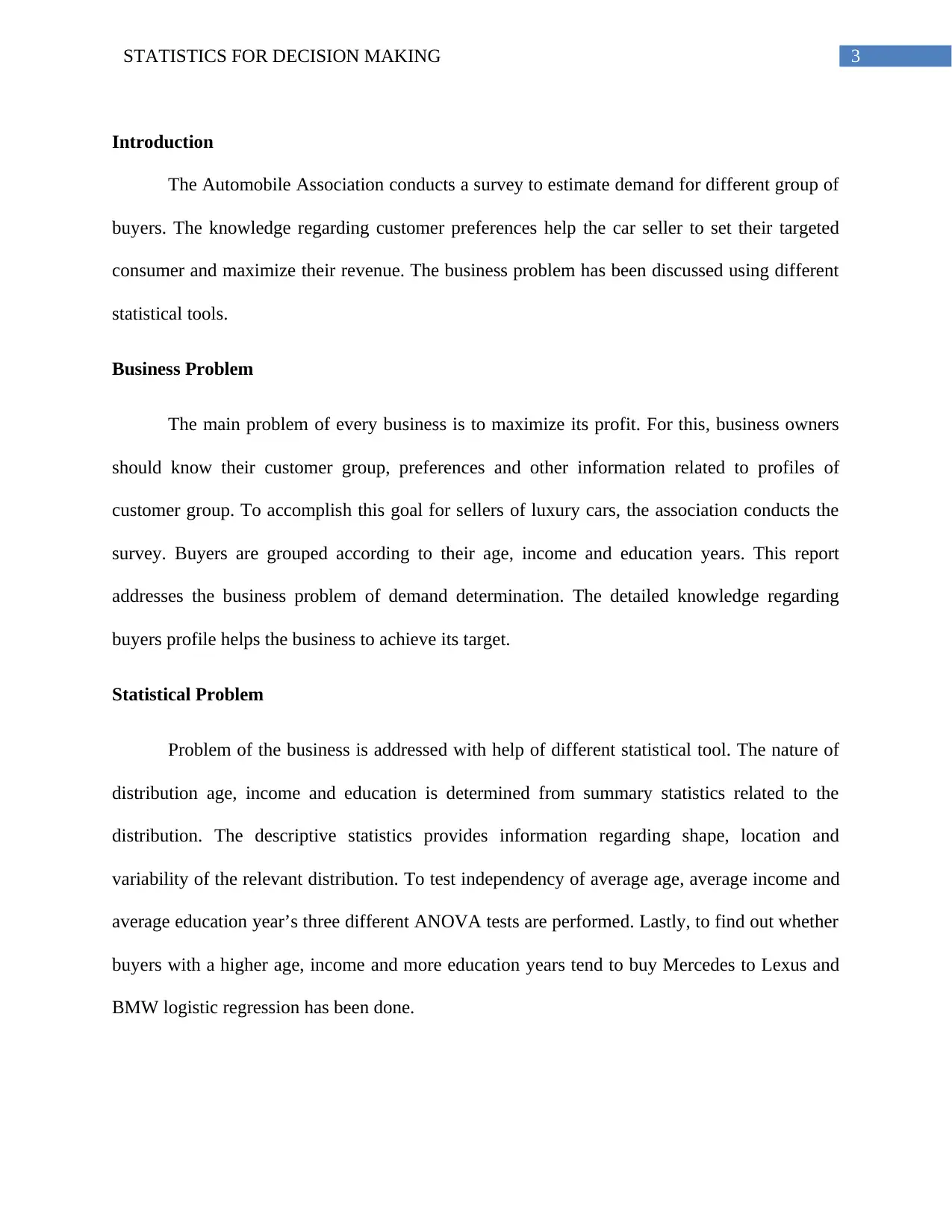
3STATISTICS FOR DECISION MAKING
Introduction
The Automobile Association conducts a survey to estimate demand for different group of
buyers. The knowledge regarding customer preferences help the car seller to set their targeted
consumer and maximize their revenue. The business problem has been discussed using different
statistical tools.
Business Problem
The main problem of every business is to maximize its profit. For this, business owners
should know their customer group, preferences and other information related to profiles of
customer group. To accomplish this goal for sellers of luxury cars, the association conducts the
survey. Buyers are grouped according to their age, income and education years. This report
addresses the business problem of demand determination. The detailed knowledge regarding
buyers profile helps the business to achieve its target.
Statistical Problem
Problem of the business is addressed with help of different statistical tool. The nature of
distribution age, income and education is determined from summary statistics related to the
distribution. The descriptive statistics provides information regarding shape, location and
variability of the relevant distribution. To test independency of average age, average income and
average education year’s three different ANOVA tests are performed. Lastly, to find out whether
buyers with a higher age, income and more education years tend to buy Mercedes to Lexus and
BMW logistic regression has been done.
Introduction
The Automobile Association conducts a survey to estimate demand for different group of
buyers. The knowledge regarding customer preferences help the car seller to set their targeted
consumer and maximize their revenue. The business problem has been discussed using different
statistical tools.
Business Problem
The main problem of every business is to maximize its profit. For this, business owners
should know their customer group, preferences and other information related to profiles of
customer group. To accomplish this goal for sellers of luxury cars, the association conducts the
survey. Buyers are grouped according to their age, income and education years. This report
addresses the business problem of demand determination. The detailed knowledge regarding
buyers profile helps the business to achieve its target.
Statistical Problem
Problem of the business is addressed with help of different statistical tool. The nature of
distribution age, income and education is determined from summary statistics related to the
distribution. The descriptive statistics provides information regarding shape, location and
variability of the relevant distribution. To test independency of average age, average income and
average education year’s three different ANOVA tests are performed. Lastly, to find out whether
buyers with a higher age, income and more education years tend to buy Mercedes to Lexus and
BMW logistic regression has been done.
Paraphrase This Document
Need a fresh take? Get an instant paraphrase of this document with our AI Paraphraser
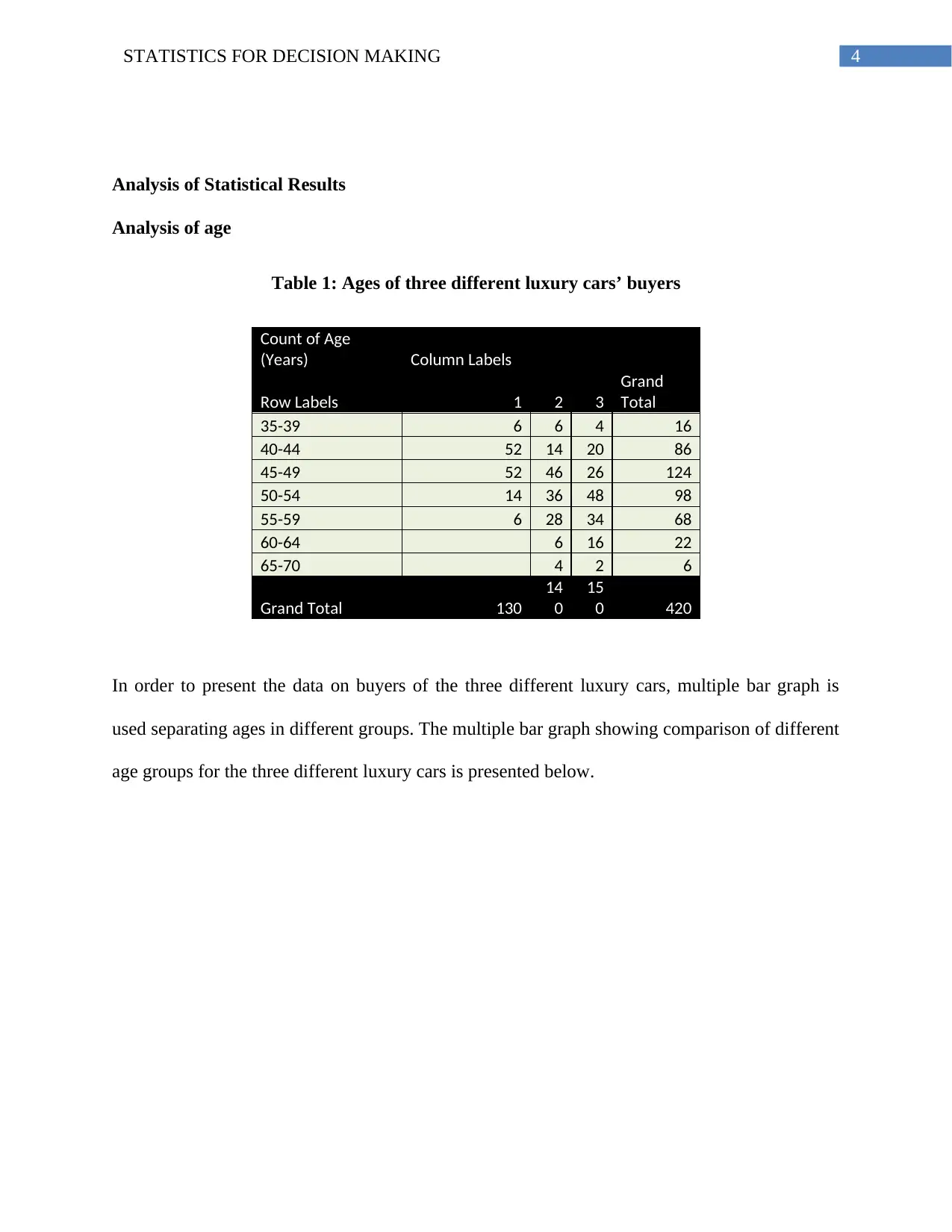
4STATISTICS FOR DECISION MAKING
Analysis of Statistical Results
Analysis of age
Table 1: Ages of three different luxury cars’ buyers
Count of Age
(Years) Column Labels
Row Labels 1 2 3
Grand
Total
35-39 6 6 4 16
40-44 52 14 20 86
45-49 52 46 26 124
50-54 14 36 48 98
55-59 6 28 34 68
60-64 6 16 22
65-70 4 2 6
Grand Total 130
14
0
15
0 420
In order to present the data on buyers of the three different luxury cars, multiple bar graph is
used separating ages in different groups. The multiple bar graph showing comparison of different
age groups for the three different luxury cars is presented below.
Analysis of Statistical Results
Analysis of age
Table 1: Ages of three different luxury cars’ buyers
Count of Age
(Years) Column Labels
Row Labels 1 2 3
Grand
Total
35-39 6 6 4 16
40-44 52 14 20 86
45-49 52 46 26 124
50-54 14 36 48 98
55-59 6 28 34 68
60-64 6 16 22
65-70 4 2 6
Grand Total 130
14
0
15
0 420
In order to present the data on buyers of the three different luxury cars, multiple bar graph is
used separating ages in different groups. The multiple bar graph showing comparison of different
age groups for the three different luxury cars is presented below.
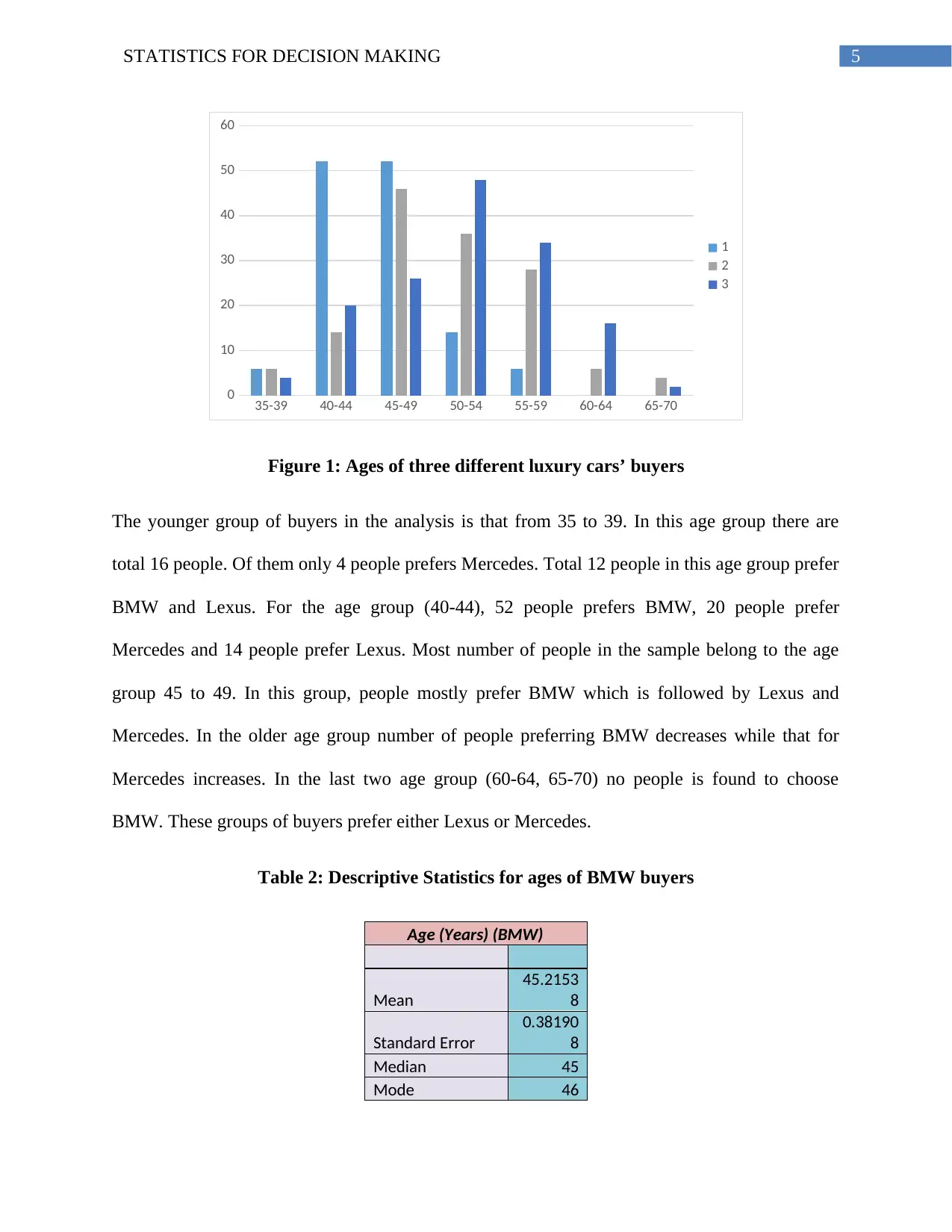
5STATISTICS FOR DECISION MAKING
35-39 40-44 45-49 50-54 55-59 60-64 65-70
0
10
20
30
40
50
60
1
2
3
Figure 1: Ages of three different luxury cars’ buyers
The younger group of buyers in the analysis is that from 35 to 39. In this age group there are
total 16 people. Of them only 4 people prefers Mercedes. Total 12 people in this age group prefer
BMW and Lexus. For the age group (40-44), 52 people prefers BMW, 20 people prefer
Mercedes and 14 people prefer Lexus. Most number of people in the sample belong to the age
group 45 to 49. In this group, people mostly prefer BMW which is followed by Lexus and
Mercedes. In the older age group number of people preferring BMW decreases while that for
Mercedes increases. In the last two age group (60-64, 65-70) no people is found to choose
BMW. These groups of buyers prefer either Lexus or Mercedes.
Table 2: Descriptive Statistics for ages of BMW buyers
Age (Years) (BMW)
Mean
45.2153
8
Standard Error
0.38190
8
Median 45
Mode 46
35-39 40-44 45-49 50-54 55-59 60-64 65-70
0
10
20
30
40
50
60
1
2
3
Figure 1: Ages of three different luxury cars’ buyers
The younger group of buyers in the analysis is that from 35 to 39. In this age group there are
total 16 people. Of them only 4 people prefers Mercedes. Total 12 people in this age group prefer
BMW and Lexus. For the age group (40-44), 52 people prefers BMW, 20 people prefer
Mercedes and 14 people prefer Lexus. Most number of people in the sample belong to the age
group 45 to 49. In this group, people mostly prefer BMW which is followed by Lexus and
Mercedes. In the older age group number of people preferring BMW decreases while that for
Mercedes increases. In the last two age group (60-64, 65-70) no people is found to choose
BMW. These groups of buyers prefer either Lexus or Mercedes.
Table 2: Descriptive Statistics for ages of BMW buyers
Age (Years) (BMW)
Mean
45.2153
8
Standard Error
0.38190
8
Median 45
Mode 46
⊘ This is a preview!⊘
Do you want full access?
Subscribe today to unlock all pages.

Trusted by 1+ million students worldwide
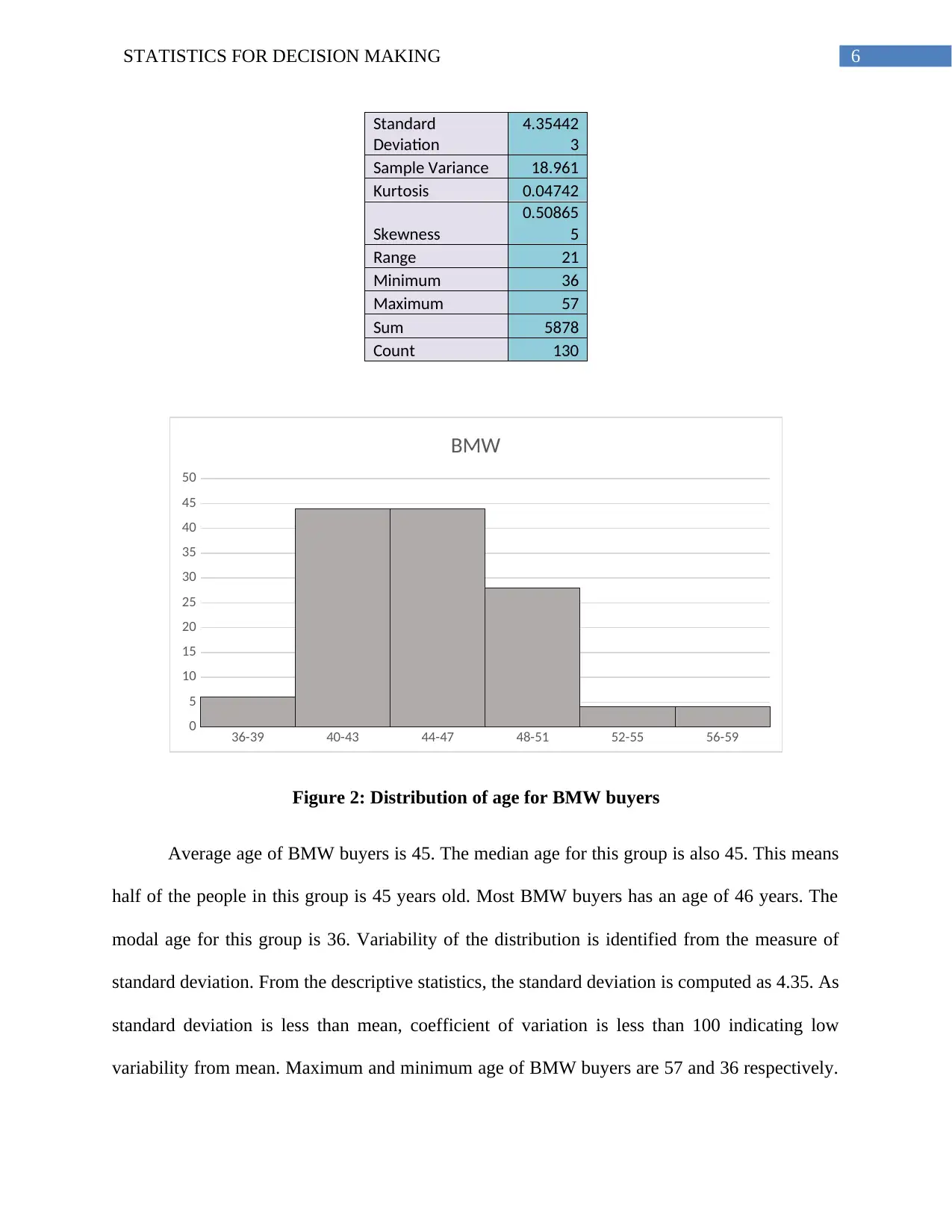
6STATISTICS FOR DECISION MAKING
Standard
Deviation
4.35442
3
Sample Variance 18.961
Kurtosis 0.04742
Skewness
0.50865
5
Range 21
Minimum 36
Maximum 57
Sum 5878
Count 130
36-39 40-43 44-47 48-51 52-55 56-59
0
5
10
15
20
25
30
35
40
45
50
BMW
Figure 2: Distribution of age for BMW buyers
Average age of BMW buyers is 45. The median age for this group is also 45. This means
half of the people in this group is 45 years old. Most BMW buyers has an age of 46 years. The
modal age for this group is 36. Variability of the distribution is identified from the measure of
standard deviation. From the descriptive statistics, the standard deviation is computed as 4.35. As
standard deviation is less than mean, coefficient of variation is less than 100 indicating low
variability from mean. Maximum and minimum age of BMW buyers are 57 and 36 respectively.
Standard
Deviation
4.35442
3
Sample Variance 18.961
Kurtosis 0.04742
Skewness
0.50865
5
Range 21
Minimum 36
Maximum 57
Sum 5878
Count 130
36-39 40-43 44-47 48-51 52-55 56-59
0
5
10
15
20
25
30
35
40
45
50
BMW
Figure 2: Distribution of age for BMW buyers
Average age of BMW buyers is 45. The median age for this group is also 45. This means
half of the people in this group is 45 years old. Most BMW buyers has an age of 46 years. The
modal age for this group is 36. Variability of the distribution is identified from the measure of
standard deviation. From the descriptive statistics, the standard deviation is computed as 4.35. As
standard deviation is less than mean, coefficient of variation is less than 100 indicating low
variability from mean. Maximum and minimum age of BMW buyers are 57 and 36 respectively.
Paraphrase This Document
Need a fresh take? Get an instant paraphrase of this document with our AI Paraphraser
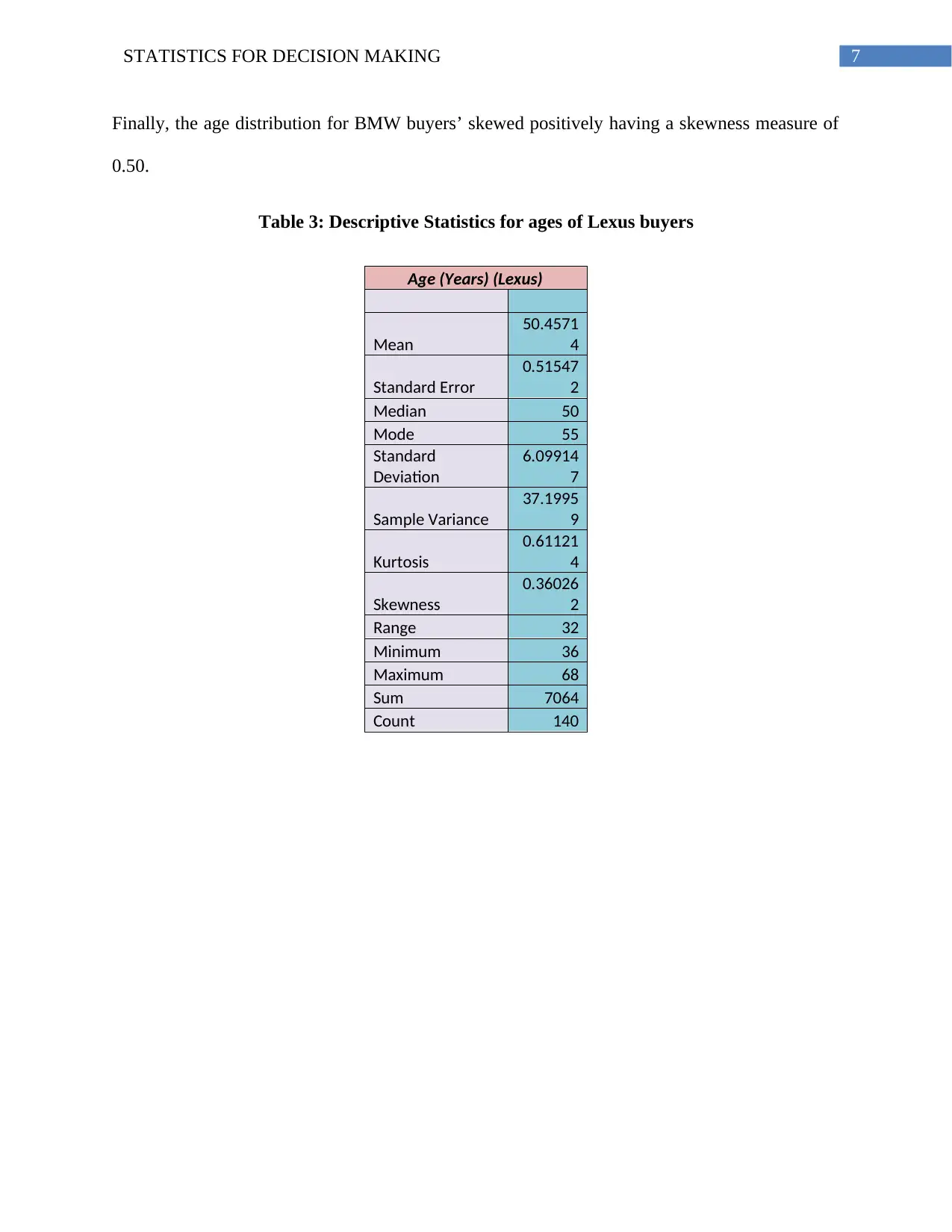
7STATISTICS FOR DECISION MAKING
Finally, the age distribution for BMW buyers’ skewed positively having a skewness measure of
0.50.
Table 3: Descriptive Statistics for ages of Lexus buyers
Age (Years) (Lexus)
Mean
50.4571
4
Standard Error
0.51547
2
Median 50
Mode 55
Standard
Deviation
6.09914
7
Sample Variance
37.1995
9
Kurtosis
0.61121
4
Skewness
0.36026
2
Range 32
Minimum 36
Maximum 68
Sum 7064
Count 140
Finally, the age distribution for BMW buyers’ skewed positively having a skewness measure of
0.50.
Table 3: Descriptive Statistics for ages of Lexus buyers
Age (Years) (Lexus)
Mean
50.4571
4
Standard Error
0.51547
2
Median 50
Mode 55
Standard
Deviation
6.09914
7
Sample Variance
37.1995
9
Kurtosis
0.61121
4
Skewness
0.36026
2
Range 32
Minimum 36
Maximum 68
Sum 7064
Count 140
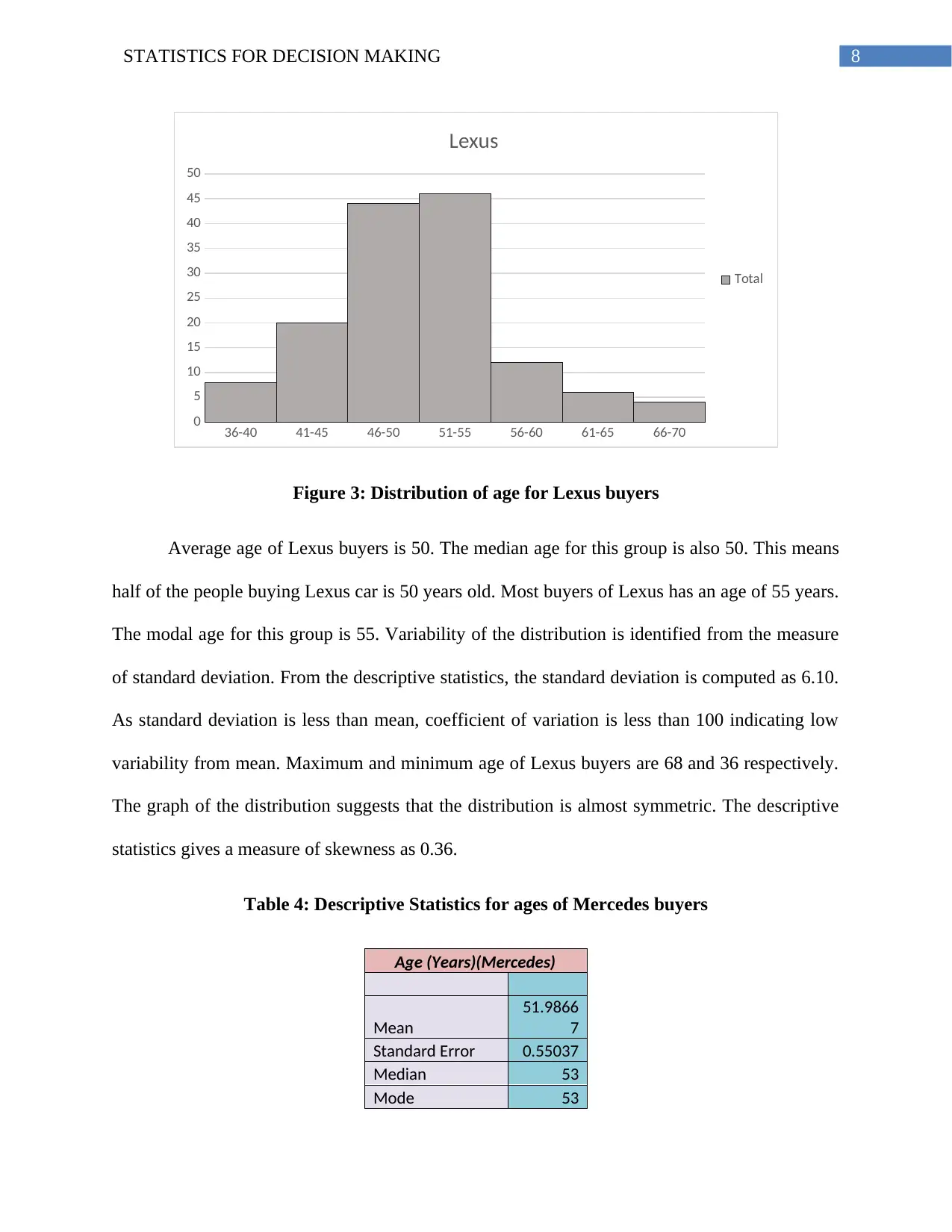
8STATISTICS FOR DECISION MAKING
36-40 41-45 46-50 51-55 56-60 61-65 66-70
0
5
10
15
20
25
30
35
40
45
50
Lexus
Total
Figure 3: Distribution of age for Lexus buyers
Average age of Lexus buyers is 50. The median age for this group is also 50. This means
half of the people buying Lexus car is 50 years old. Most buyers of Lexus has an age of 55 years.
The modal age for this group is 55. Variability of the distribution is identified from the measure
of standard deviation. From the descriptive statistics, the standard deviation is computed as 6.10.
As standard deviation is less than mean, coefficient of variation is less than 100 indicating low
variability from mean. Maximum and minimum age of Lexus buyers are 68 and 36 respectively.
The graph of the distribution suggests that the distribution is almost symmetric. The descriptive
statistics gives a measure of skewness as 0.36.
Table 4: Descriptive Statistics for ages of Mercedes buyers
Age (Years)(Mercedes)
Mean
51.9866
7
Standard Error 0.55037
Median 53
Mode 53
36-40 41-45 46-50 51-55 56-60 61-65 66-70
0
5
10
15
20
25
30
35
40
45
50
Lexus
Total
Figure 3: Distribution of age for Lexus buyers
Average age of Lexus buyers is 50. The median age for this group is also 50. This means
half of the people buying Lexus car is 50 years old. Most buyers of Lexus has an age of 55 years.
The modal age for this group is 55. Variability of the distribution is identified from the measure
of standard deviation. From the descriptive statistics, the standard deviation is computed as 6.10.
As standard deviation is less than mean, coefficient of variation is less than 100 indicating low
variability from mean. Maximum and minimum age of Lexus buyers are 68 and 36 respectively.
The graph of the distribution suggests that the distribution is almost symmetric. The descriptive
statistics gives a measure of skewness as 0.36.
Table 4: Descriptive Statistics for ages of Mercedes buyers
Age (Years)(Mercedes)
Mean
51.9866
7
Standard Error 0.55037
Median 53
Mode 53
⊘ This is a preview!⊘
Do you want full access?
Subscribe today to unlock all pages.

Trusted by 1+ million students worldwide

9STATISTICS FOR DECISION MAKING
Standard
Deviation
6.74062
8
Sample Variance
45.4360
6
Kurtosis -0.0195
Skewness -0.02894
Range 35
Minimum 35
Maximum 70
Sum 7798
Count 150
35-39 40-44 45-49 50-54 55-59 60-64 65-70
0
10
20
30
40
50
60
Mercedes
Total
Figure 4: Distribution of age for Mercedes buyers
Mean age of Mercedes buyers is 52. The median age for this group is also 53. This means
half of the people in this group is 53 years old. Most Mercedes buyers has an age of 53 years.
The modal age for this group is 53. From the descriptive statistics, the standard deviation is
computed as 6.74. As standard deviation is less than mean, coefficient of variation is less than
100 indicating low variability from mean. Maximum and minimum age of BMW buyers are 70
Standard
Deviation
6.74062
8
Sample Variance
45.4360
6
Kurtosis -0.0195
Skewness -0.02894
Range 35
Minimum 35
Maximum 70
Sum 7798
Count 150
35-39 40-44 45-49 50-54 55-59 60-64 65-70
0
10
20
30
40
50
60
Mercedes
Total
Figure 4: Distribution of age for Mercedes buyers
Mean age of Mercedes buyers is 52. The median age for this group is also 53. This means
half of the people in this group is 53 years old. Most Mercedes buyers has an age of 53 years.
The modal age for this group is 53. From the descriptive statistics, the standard deviation is
computed as 6.74. As standard deviation is less than mean, coefficient of variation is less than
100 indicating low variability from mean. Maximum and minimum age of BMW buyers are 70
Paraphrase This Document
Need a fresh take? Get an instant paraphrase of this document with our AI Paraphraser
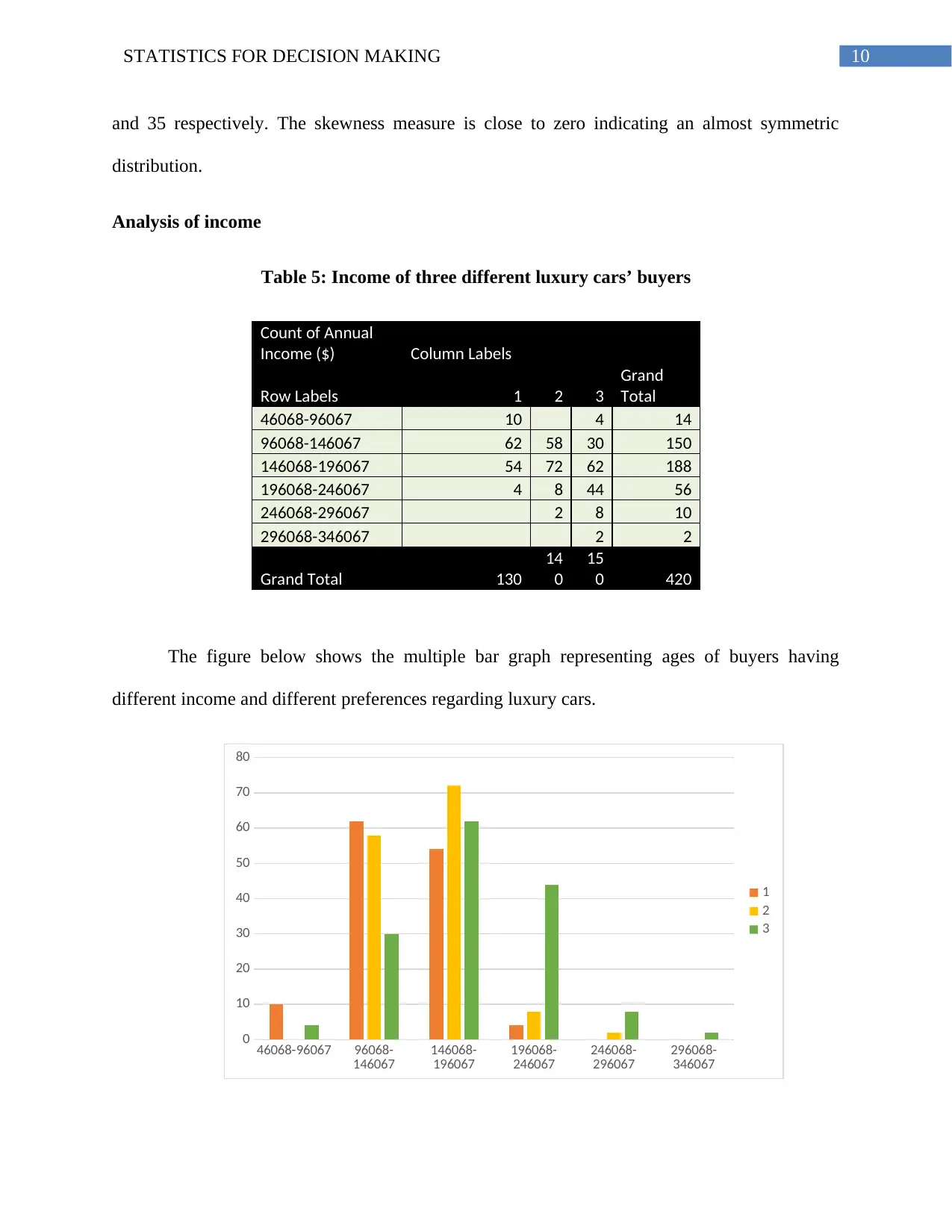
10STATISTICS FOR DECISION MAKING
and 35 respectively. The skewness measure is close to zero indicating an almost symmetric
distribution.
Analysis of income
Table 5: Income of three different luxury cars’ buyers
Count of Annual
Income ($) Column Labels
Row Labels 1 2 3
Grand
Total
46068-96067 10 4 14
96068-146067 62 58 30 150
146068-196067 54 72 62 188
196068-246067 4 8 44 56
246068-296067 2 8 10
296068-346067 2 2
Grand Total 130
14
0
15
0 420
The figure below shows the multiple bar graph representing ages of buyers having
different income and different preferences regarding luxury cars.
46068-96067 96068-
146067 146068-
196067 196068-
246067 246068-
296067 296068-
346067
0
10
20
30
40
50
60
70
80
1
2
3
and 35 respectively. The skewness measure is close to zero indicating an almost symmetric
distribution.
Analysis of income
Table 5: Income of three different luxury cars’ buyers
Count of Annual
Income ($) Column Labels
Row Labels 1 2 3
Grand
Total
46068-96067 10 4 14
96068-146067 62 58 30 150
146068-196067 54 72 62 188
196068-246067 4 8 44 56
246068-296067 2 8 10
296068-346067 2 2
Grand Total 130
14
0
15
0 420
The figure below shows the multiple bar graph representing ages of buyers having
different income and different preferences regarding luxury cars.
46068-96067 96068-
146067 146068-
196067 196068-
246067 246068-
296067 296068-
346067
0
10
20
30
40
50
60
70
80
1
2
3

11STATISTICS FOR DECISION MAKING
Figure 5: Income of three different luxury cars’ buyers
People buying different luxury cars have different range of income. For convenient of the
analysis incomes are categorized in different groups. In the lowest income group having an
income between $46068 and $96067, there is no people buying Lexus. In this group, 10 people
buys BMW and only 4 people buys Mercedes. In the sample, most people belong to the income
group ranging from $146068 to $196067. In this group, most people buy Lexus. As income
increases, people buying Mercedes increase while that of BMW and Lexus decreases. There are
only 2 people in the highest income group ranging between 296068 and 346067 and both buys
Mercedes.
Table 6: Descriptive Statistics for incomes of BMW buyers
Annual Income ($)(BMW)
Mean 139271.3
Standard Error 2907.846
Median 138512
Mode 109568
Standard
Deviation 33154.54
Sample Variance 1.1E+09
Kurtosis -0.22439
Skewness -0.03855
Range 170652
Minimum 46068
Maximum 216720
Sum
1810527
4
Count 130
Figure 5: Income of three different luxury cars’ buyers
People buying different luxury cars have different range of income. For convenient of the
analysis incomes are categorized in different groups. In the lowest income group having an
income between $46068 and $96067, there is no people buying Lexus. In this group, 10 people
buys BMW and only 4 people buys Mercedes. In the sample, most people belong to the income
group ranging from $146068 to $196067. In this group, most people buy Lexus. As income
increases, people buying Mercedes increase while that of BMW and Lexus decreases. There are
only 2 people in the highest income group ranging between 296068 and 346067 and both buys
Mercedes.
Table 6: Descriptive Statistics for incomes of BMW buyers
Annual Income ($)(BMW)
Mean 139271.3
Standard Error 2907.846
Median 138512
Mode 109568
Standard
Deviation 33154.54
Sample Variance 1.1E+09
Kurtosis -0.22439
Skewness -0.03855
Range 170652
Minimum 46068
Maximum 216720
Sum
1810527
4
Count 130
⊘ This is a preview!⊘
Do you want full access?
Subscribe today to unlock all pages.

Trusted by 1+ million students worldwide
1 out of 32
Related Documents
Your All-in-One AI-Powered Toolkit for Academic Success.
+13062052269
info@desklib.com
Available 24*7 on WhatsApp / Email
![[object Object]](/_next/static/media/star-bottom.7253800d.svg)
Unlock your academic potential
Copyright © 2020–2025 A2Z Services. All Rights Reserved. Developed and managed by ZUCOL.


